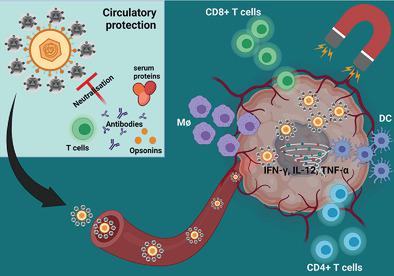Our official English website, www.x-mol.net, welcomes your feedback! (Note: you will need to create a separate account there.)
Nanobugs as Drugs: Bacterial Derived Nanomagnets Enhance Tumor Targeting and Oncolytic Activity of HSV-1 Virus
Small ( IF 13.0 ) Pub Date : 2022-01-25 , DOI: 10.1002/smll.202104763 Faith H N Howard 1 , Haider Al-Janabi 1 , Priya Patel 1 , Katie Cox 1 , Emily Smith 2 , Jayakumar Vadakekolathu 3 , A Graham Pockley 3 , Joe Conner 4 , James F Nohl 5 , Dan A Allwood 5 , Cristal Collado-Rojas 1 , Aneurin Kennerley 6 , Sarah Staniland 7 , Munitta Muthana 1
Small ( IF 13.0 ) Pub Date : 2022-01-25 , DOI: 10.1002/smll.202104763 Faith H N Howard 1 , Haider Al-Janabi 1 , Priya Patel 1 , Katie Cox 1 , Emily Smith 2 , Jayakumar Vadakekolathu 3 , A Graham Pockley 3 , Joe Conner 4 , James F Nohl 5 , Dan A Allwood 5 , Cristal Collado-Rojas 1 , Aneurin Kennerley 6 , Sarah Staniland 7 , Munitta Muthana 1
Affiliation

|
The survival strategies of infectious organisms have inspired many therapeutics over the years. Indeed the advent of oncolytic viruses (OVs) exploits the uncontrolled replication of cancer cells for production of their progeny resulting in a cancer-targeting treatment that leaves healthy cells unharmed. Their success against inaccessible tumors however, is highly variable due to inadequate tumor targeting following systemic administration. Coassembling herpes simplex virus (HSV1716) with biocompatible magnetic nanoparticles derived from magnetotactic bacteria enables tumor targeting from circulation with magnetic guidance, protects the virus against neutralizing antibodies and thereby enhances viral replication within tumors. This approach additionally enhances the intratumoral recruitment of activated immune cells, promotes antitumor immunity and immune cell death, thereby inducing tumor shrinkage and increasing survival in a syngeneic mouse model of breast cancer by 50%. Exploiting the properties of such a nanocarrier, rather than tropism of the virus, for active tumor targeting offers an exciting, novel approach for enhancing the bioavailability and treatment efficacy of tumor immunotherapies for disseminated neoplasms.
中文翻译:

纳米细菌作为药物:细菌衍生的纳米磁体增强 HSV-1 病毒的肿瘤靶向和溶瘤活性
多年来,传染性生物的生存策略激发了许多治疗方法。事实上,溶瘤病毒 (OVs) 的出现利用了癌细胞不受控制的复制来产生它们的后代,从而产生了一种癌症靶向治疗,使健康细胞不受伤害。然而,由于全身给药后肿瘤靶向不足,它们对难以接近的肿瘤的成功是高度可变的。将单纯疱疹病毒 (HSV1716) 与源自趋磁细菌的生物相容性磁性纳米颗粒共组装,可以通过磁性引导从循环中靶向肿瘤,保护病毒免受中和抗体的影响,从而增强肿瘤内的病毒复制。这种方法还增强了活化免疫细胞的肿瘤内募集,促进抗肿瘤免疫和免疫细胞死亡,从而诱导肿瘤缩小并将乳腺癌同基因小鼠模型的存活率提高 50%。利用这种纳米载体的特性,而不是病毒的嗜性,主动靶向肿瘤提供了一种令人兴奋的新方法,可以提高肿瘤免疫疗法对播散性肿瘤的生物利用度和治疗效果。
更新日期:2022-01-25
中文翻译:

纳米细菌作为药物:细菌衍生的纳米磁体增强 HSV-1 病毒的肿瘤靶向和溶瘤活性
多年来,传染性生物的生存策略激发了许多治疗方法。事实上,溶瘤病毒 (OVs) 的出现利用了癌细胞不受控制的复制来产生它们的后代,从而产生了一种癌症靶向治疗,使健康细胞不受伤害。然而,由于全身给药后肿瘤靶向不足,它们对难以接近的肿瘤的成功是高度可变的。将单纯疱疹病毒 (HSV1716) 与源自趋磁细菌的生物相容性磁性纳米颗粒共组装,可以通过磁性引导从循环中靶向肿瘤,保护病毒免受中和抗体的影响,从而增强肿瘤内的病毒复制。这种方法还增强了活化免疫细胞的肿瘤内募集,促进抗肿瘤免疫和免疫细胞死亡,从而诱导肿瘤缩小并将乳腺癌同基因小鼠模型的存活率提高 50%。利用这种纳米载体的特性,而不是病毒的嗜性,主动靶向肿瘤提供了一种令人兴奋的新方法,可以提高肿瘤免疫疗法对播散性肿瘤的生物利用度和治疗效果。






































 京公网安备 11010802027423号
京公网安备 11010802027423号